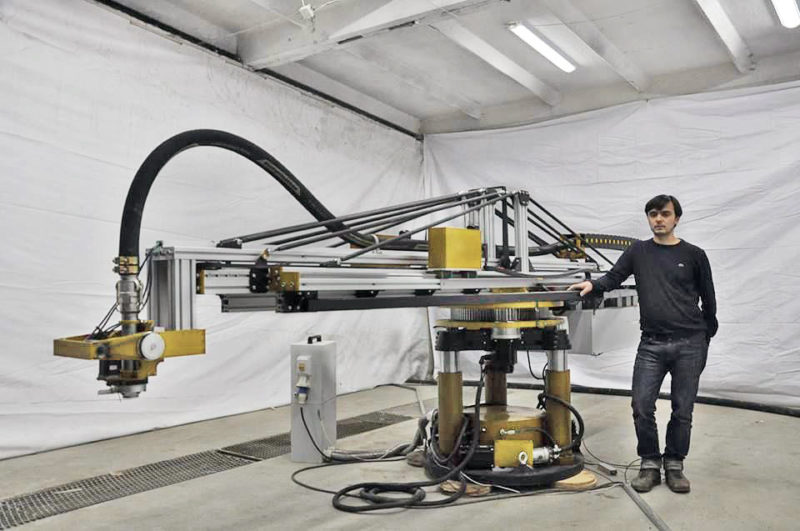FDM (Fused Deposition Modeling) Yazıcılar

- Eritilmiş plastik filamanı katman katman sererek modeller oluşturur.
- En yaygın ve uygun fiyatlı 3D yazıcı türüdür.
SLA (Stereolitografi) Yazıcılar

- Sıvı fotopolimer reçineyi UV ışığı ile katılaştırarak modeller oluşturur.
- Yüksek hassasiyetli parçalar üretir.
SLS (Selective Laser Sintering) Yazıcılar

- Toz halindeki malzemeyi lazerle sinterleyerek modeller oluşturur.
- Metal, seramik ve plastik gibi çeşitli malzemelerle çalışabilir.
MJF (Multi-Jet Fusion) Yazıcılar
- Birden fazla ince malzeme damlacığını birleştirerek modeller oluşturur.
- Hızlı yazdırma süreleri ve düşük maliyetler sağlar.
DLP (Digital Light Processing) Yazıcılar
- SLA yazıcılara benzer şekilde fotopolimer reçineyi kullanır, ancak görüntüleri projektörlerle yansıtarak üretir.
PolyJet Yazıcılar
- Birden fazla sıvı malzemeyi püskürterek çok renkli ve çok dokulu parçalar oluşturur.
Vazgeçirici Yüzeyli Yazıcılar
- Katılaşmamış malzemenin altından destek malzemeleri çıkararak modeller oluşturur.
- Karmaşık geometrili modeller için uygundur.
Metal Yazıcılar
- Metal tozunu veya erimiş metal damlacıklarını birleştirerek metal parçalar oluşturur.
- Yüksek mukavemet ve dayanıklılık sağlar.
Bio Yazıcılar
- Canlı hücreleri ve biyolojik malzemeleri kullanarak organ ve doku benzeri yapılar oluşturur.
- Tıbbi araştırmalar ve doku mühendisliği için kullanılır.
Hidrojel Yazıcılar
- Suda şişebilen ve yumuşak, elastik parçalar oluşturabilen hidrojel malzemeler kullanır.
- Giyilebilir cihazlar ve yumuşak robotlar için uygundur.[3d yazıcı türleri]
Executive Summary
This comprehensive guide delves into the diverse landscape of 3D printing technologies, empowering readers to make informed decisions based on their specific requirements. By exploring the nuances of each technology, the guide equips readers with the knowledge necessary to leverage the transformative power of 3D printing.
Introduction
3D printing, a revolutionary manufacturing technique, has gained immense popularity across industries, enabling the creation of intricate designs, prototypes, and functional products. With a plethora of technologies available, understanding their distinctions is crucial for optimizing project outcomes. This guide unveils the key 3D printing technologies, providing insights into their capabilities, advantages, and limitations.
Frequently Asked Questions (FAQs)
What is the most suitable 3D printing technology for beginners?
- Fused Deposition Modeling (FDM) is an accessible and affordable option, ideal for hobbyists and educational purposes.
What materials can be used in 3D printing?
- A wide range of materials is available, including plastics, metals, ceramics, and biomaterials, enabling diverse applications.
How complex can 3D printed designs be?
- The complexity of designs is limited by the capabilities of the specific printing technology and software.
Subtopics
Fused Deposition Modeling (FDM)
FDM is a widely adopted technology that extrudes molten thermoplastic material through a nozzle, building objects layer by layer.
- High affordability and accessibility: FDM printers are relatively inexpensive, making them ideal for prototyping and hobbyists.
- Wide material compatibility: FDM utilizes various thermoplastics, offering diverse material properties and colors.
- Moderate resolution: FDM prints exhibit visible layer lines, limiting their suitability for highly detailed objects.
- Limited strength: FDM prints may have lower strength compared to other technologies, requiring post-processing for enhanced durability.
- Time-consuming process: FDM builds objects one layer at a time, resulting in longer printing durations.
Stereolithography (SLA)
SLA employs a laser to cure liquid resin, building objects layer by layer.
- High accuracy and resolution: SLA prints boast smooth surfaces and intricate details, ideal for prototyping and high-quality models.
- Wide material selection: A variety of resins are available, ranging from flexible to rigid, offering versatile properties.
- Limited build size: SLA printers have smaller build platforms compared to other technologies, restricting the size of printable objects.
- Specialized materials: SLA materials can be more expensive and require specific post-processing steps.
- Longer post-processing: SLA prints necessitate extended post-processing, including cleaning and curing.
Selective Laser Sintering (SLS)
SLS uses a laser to fuse powdered material particles, building objects directly from computer-aided design (CAD) data.
- Durable and strong materials: SLS prints exhibit exceptional strength and durability, making them suitable for functional parts and end-use products.
- High build speed: SLS is relatively fast compared to other powder-bed technologies.
- Complex geometries: SLS enables the production of intricate and complex designs, including internal channels and undercuts.
- Limited material selection: SLS materials are primarily thermoplastic powders, limiting material diversity.
- Costly equipment and materials: SLS printers and materials can be expensive, requiring significant investment.
Digital Light Processing (DLP)
DLP employs a projector to cure liquid resin, similar to SLA but with an entire layer at a time.
- High accuracy and resolution: DLP prints offer exceptional detail and accuracy, comparable to SLA.
- Faster print speeds: DLP cures entire layers simultaneously, resulting in quicker printing times than SLA.
- Limited material compatibility: DLP resins are more limited in variety compared to SLA materials.
- Smaller build size: DLP printers typically have smaller build areas than FDM and SLS technologies.
- Specialized materials: DLP resins can be more expensive and require specific post-processing techniques.
Metal 3D Printing
Metal 3D printing encompasses various techniques that utilize metal powders or wires to create objects layer by layer.
- Exceptional durability and strength: Metal 3D prints exhibit outstanding strength and durability, making them perfect for industrial and aerospace applications.
- Wide range of metals: Metal 3D printing enables the fabrication of objects using various metals, including titanium, stainless steel, and aluminum.
- Complex geometries: Metal 3D printing allows the production of intricate and complex designs that are difficult to achieve with traditional manufacturing techniques.
- Costly process: Metal 3D printing involves specialized equipment and materials, resulting in higher costs.
- Limited surface finish: Metal 3D prints may require post-processing to achieve desired surface finishes.
Conclusion
The realm of 3D printing technologies offers a diverse array of options, each catering to specific requirements. Understanding the strengths and limitations of each technology empowers users to make informed choices based on their project goals. By leveraging the transformative power of 3D printing, we unlock limitless possibilities for innovation, rapid prototyping, and the production of complex and functional objects.
Relevant Keyword Tags
- 3D printing
- FDM
- SLA
- SLS
- Metal 3D printing
